[NOTE: This is the second installment in the "Run, Duke, Run!" series. If you have not read the previous episode, you might want to do that now.]
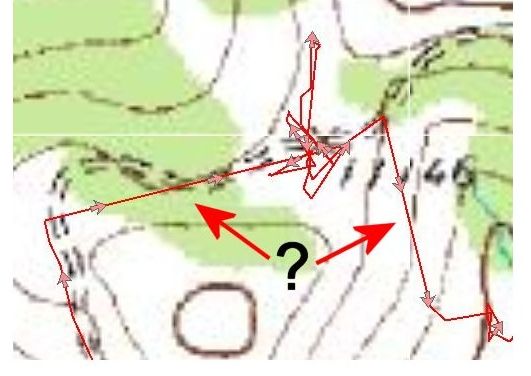 As you may recall, one of the limitations in our first "Run, Duke, Run" test was the tendency of the Garmin Forerunner 301 GPS to lose satellite reception in dark forest. [NOTE: By "dark forest" we don't mean Amazon jungle canopy where no light penetrates to the ground. Instead we are talking about the common evergreen forest found 9000' above sea level in the Rocky Mountains. We consider this to be a "medium density" forest as you can often see the sky directly overhead even with trees all around. This is (obviously) our own terminology, we have not consulted with any forest experts about the proper nomenclature for forest canopy density.]
As you may recall, one of the limitations in our first "Run, Duke, Run" test was the tendency of the Garmin Forerunner 301 GPS to lose satellite reception in dark forest. [NOTE: By "dark forest" we don't mean Amazon jungle canopy where no light penetrates to the ground. Instead we are talking about the common evergreen forest found 9000' above sea level in the Rocky Mountains. We consider this to be a "medium density" forest as you can often see the sky directly overhead even with trees all around. This is (obviously) our own terminology, we have not consulted with any forest experts about the proper nomenclature for forest canopy density.]
The tendency to lose satellite reception is graphically illustrated by the plot of our GPS track when traveling on a winding trail through dark forest. In the illustration at left, the bold red arrows point out sections of the GPS track which Duke supposedly ran near the top of Reno Divide. Note the ruler-straight red track from the left side to the middle. Compare this straight line with the curvy double dashed lines of the Italian Mountain road on the topo - the approximate path Duke took while running with us. The same problem occured on the right side as we started down the not straight Flag Creek trail. The only time we have ever seen a dog run straight was to a food bowl - a stationary object of great canine desire.
No, Duke did not run a straight line from the road to the Reno Divide saddle. What we think happened was the Forerunner lost the satellite signals when we entered the dark forest (green area on the map) and did not re-acquire said signals until we reached an open meadow and slowed down. No big deal we thought, the bike rider versus dog comparison worked because the same GPS was used for both human ride and canine run. Nevertheless, the flyingcracker scientific mind was not really satisfied...
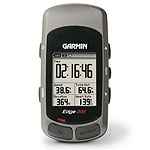 GPS signals are extremely weak - the satellite constellation is twelve thousand six hundred (12,600) miles above Earth's surface. Therefore you need a very sensitive receiver for accurate and continuous reception in forested areas or canyons. [Read more about GPS history and technology.] After our first research project we found that Garmin had recently released a slew of new GPS units, all employing the new high-sensitivity SiRFstarIII™ receiver. Supposedly this receiver could maintain a lock on satellite signals in poor conditions. We quickly ordered a Garmin Edge 305 GPS receiver (shown at left) from Geo.Man in Santa Fe, NM. The new GPS arrived a few days later.
GPS signals are extremely weak - the satellite constellation is twelve thousand six hundred (12,600) miles above Earth's surface. Therefore you need a very sensitive receiver for accurate and continuous reception in forested areas or canyons. [Read more about GPS history and technology.] After our first research project we found that Garmin had recently released a slew of new GPS units, all employing the new high-sensitivity SiRFstarIII™ receiver. Supposedly this receiver could maintain a lock on satellite signals in poor conditions. We quickly ordered a Garmin Edge 305 GPS receiver (shown at left) from Geo.Man in Santa Fe, NM. The new GPS arrived a few days later.
We also made another equipment change. During our previous Reno - Deadman ride we noticed that Duke's harness twisted around quite a bit, allowing the GPS to sag and perhaps affect reception. As that harness was designed for a smaller dog (our Toby in fact) this wasn't surprising. So we visited Mountain Tails in Crested Butte where Autumn outfitted Duke with a new properly sized hemp-fabric harness. The fit is much better and the GPS stays on top of Duke's back where Mother Nature intended.
For our test hike we chose a trail off Cement Creek Road near the Pioneer Guest Cabins owned by Matt and Leah Whiting. Mrs. Flyingcracker and I parked our car, unloaded the dogs, started the timer on Duke's new GPS and began hiking. As always we kept Duke on a leash for the initial portion of the hike which traverses private property. The trail quickly enters "dark forest", meandering along relatively level ground paralleling Cement Creek. We released Duke from his good-behaviour leash and he set out to discover all the many secrets this trail had to offer.
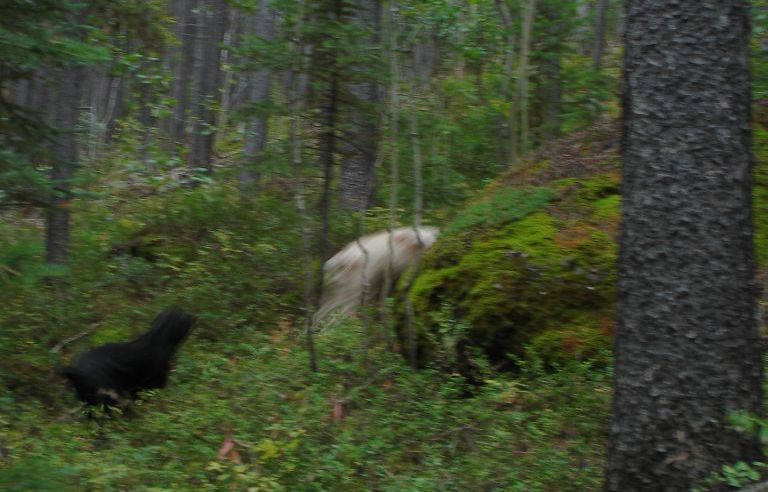
As you can see, Duke, followed closely by Ceilidh, is a white blur hellbent on finding anything of scent in the domain. This is a typical human view of Duke, a white flash seen from behind. Notice the beautiful mature moss and lichen on the big rock. This type of flora is everywhere on this trail, but especially so after this wet summer.
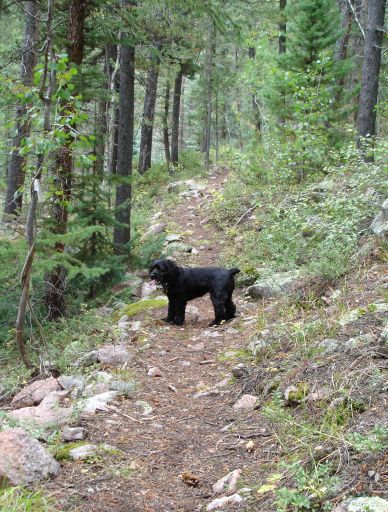
At some point in the hike, long after our last sighting of Duke, Ceilidh posed for the camera. She enjoys this trail very much - it it just new enough on each visit to be exciting but also familiar enough to be comfortable. Ceilidh doesn't wander far afield, but she is willing to pursue a good game. For instance, after Duke has worked off his initial nervous energy and run around a bit, Ceilidh chases and follows him through the brush. She nips his heels and bites his ears to ensure he knows who is boss. But after every foray into the wild she returns to her human friends. We figure that Cocker Spaniels, known as "companion" dogs, really do like to have their humans nearby.
Note the nice rock border on the trail. We're not sure if this work was done by Matt & Leah or Mike Martin, previous owner of the Cabins.
On this particular jaunt we stopped fairly quickly with the threat of imminent rain, just beyond a primitive wood "bridge" over a small stream. We paused for a minute or two to contemplate Nature's beauty and then proceeded back the way we came. Duke eventually roared up behind us, shooting past like a twenty-something hot-rodder from Bruce Springsteen's "Darkness on the Edge of Town". No, there isn't much subtle about Duke on a slow hike. With mountain bikers he is actually more respectful. He'll usually run behind them if they are moving fast enough, and if he does get out in front on the trail he pretty quickly realizes that he is in the wrong position in the parade. He'll pull off the trail, turn his head and watch and wait until the first rider passes, then immediately fall in behind her... Duke always follows, but he doesn't follow anyone except the leader.
Eventually we reached the trailhead once again and rounded up Duke for re-attachment to his leash. Back at the car we stopped the GPS, put the wet dogs in the back, and returned home.
A quick view of the GPS track for Duke's run proved astonishing. Every part of his run was curvy - tight, shallow, bodacious, whatever - the GPS really seemed to pick up the essence of his adventure. Here a portion of his trail is shown in red.

The next day we re-enacted the hike, but this time from the perspective of a human hiker. We attached the GPS above the bill of our sun visor with two strips of medical micro-pore paper tape. Then we set off, following the exact same path as the previous day. Eventually we arrived at our spot just beyond the "bridge" and spun 180 degrees for the return trip. Back at flyingcracker headquarters we examined the data from our hike. This is a portion of the hiker route shown in green. Fairly smooth track, about what you might expect on a small meandering trail in the woods.
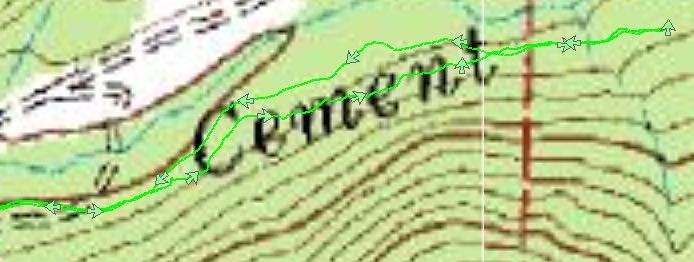
Here is a view of the entire route with both tracks superimposed using Google Earth. The hiker is the green line, Duke's path is depicted in red.
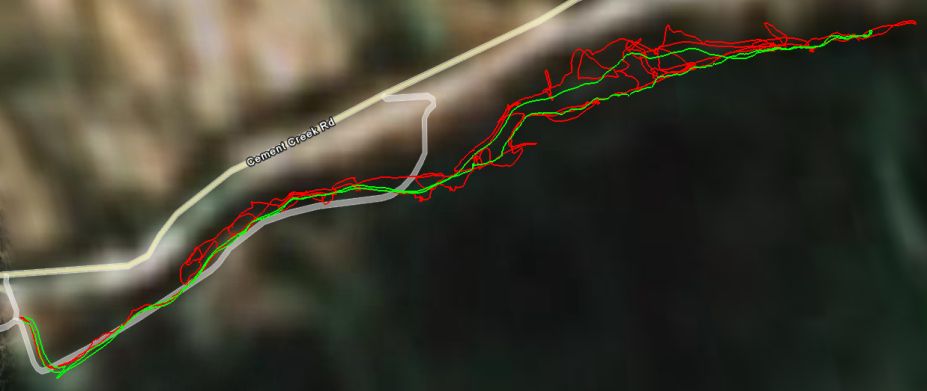
A close-up of crossing paths. Again the hiker is green and Duke is red. Notice the nice smooth curves, courtesy of the much-improved GPS reception of the Edge. Duke seems to like loop-back maneuvers on the trail - maybe all dogs are the same. Notice Duke almost completed a five-point star on the bottom left. This is a trick we've been working on for months. He's almost got it.
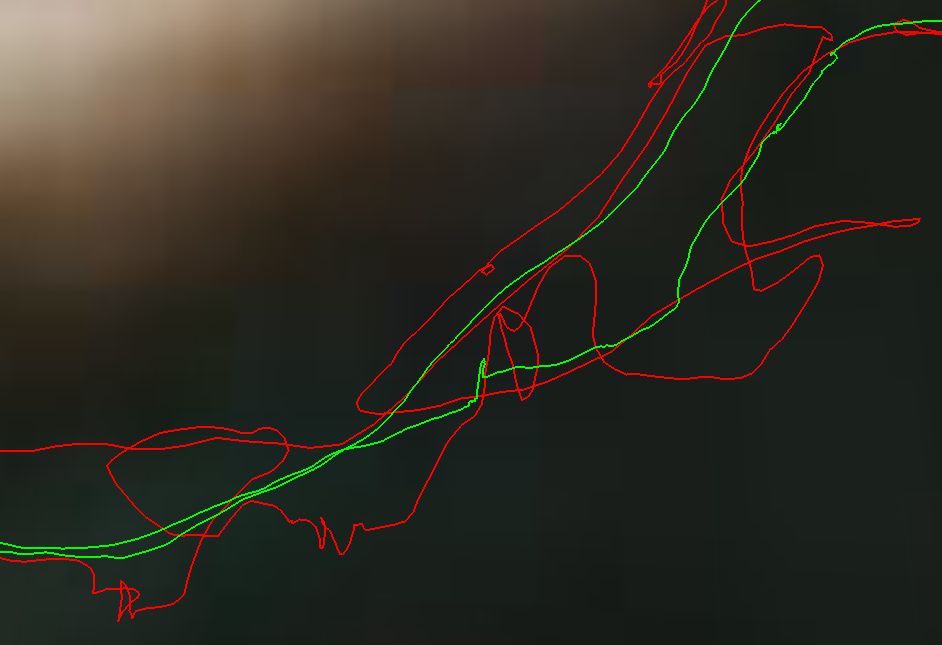
"Ok," you say, "enough with the story, cut to the chase! How much more did Duke run?" Righto. According to the Edge 305 GPS our intrepid hiker covered 1.68 miles, moving for 33:21 (min:sec) and standing still for 13:43. On Duke's jaunt the GPS recorded 3.63 miles traveled in 37:37 with a surprising stand-still ( speed less than 1 mph ) accumulation of 2:55. These figures equate to a difference of 1.95 miles. Therefore Duke ran 116% farther than the hiker, a little more than twice the distance! Contrast this with the measly 18.5% farther he ran compared to the mountain biker in our previous episode and you have to ask yourself, "Self, how could the difference be so great? Perhaps flyingcracker should run the Reno-Flag-Bear-Deadman test with Duke once again, using the new Edge GPS!"
Good idea. The results of that experiment will be the topic of our next installment of "Run, Duke, Run!" Stay tuned...